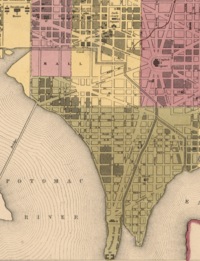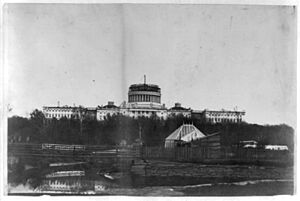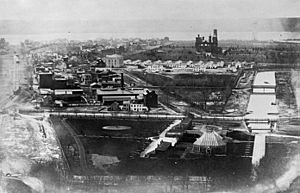Washington City Canal facts for kids
Quick facts for kids Washington City Canal |
|
|---|---|

Washington City Canal in 1851
|
|
| Specifications | |
| Status | Underground under Constitution Avenue |
| History | |
| Date of first use | 1815 |
| Date closed | 1871 |
The Washington City Canal was a waterway that operated in Washington, D.C. from 1815 until the mid-1850s. This canal helped connect the Anacostia River (then called the "Eastern Branch") to Tiber Creek, the Potomac River, and later the Chesapeake and Ohio Canal. Over time, the canal was used less and less. By 1871, the city government began covering or filling in different parts of it.
Today, the canal's Lockkeeper's House, built in 1837, is still standing. You can find it at the corner of 17th Street and Constitution Avenue, near Constitution Gardens. It is the oldest building on the National Mall.
Contents
History of the Washington City Canal
How the Canal Opened and Operated
The Washington City Canal officially opened in late 1815. It started near the Washington Navy Yard on the Eastern Branch of the Anacostia River. From there, it traveled north and then northwest. The canal passed by the Capitol Building. It then turned northwest at the base of Jenkins Hill, also known as Capitol Hill.
The canal then turned north, crossing the area where the National Mall is now. Finally, it turned sharply west. It joined a straightened part of Tiber Creek, which used to flow west. The canal then entered the Potomac River where Tiber Creek used to flow out, south of the White House.
When it was first built, the Washington City Canal was quite shallow. Only boats that needed 3 feet of water or less could use it. The canal's design did not handle the changing water levels from the tides very well. This meant that at high tide, the canal sometimes overflowed. At low tide, there wasn't enough water for boats.
Boats continued to use the canal, but it faced money problems. In 1831, the city bought the company that owned the canal. The city made some repairs in the 1830s. The U.S. Congress also gave some money in 1833 to help.
Connecting to the Chesapeake and Ohio Canal
In 1833, an extension of the Chesapeake and Ohio Canal was finished. This extension was called the Washington Branch of the C&O Canal. It allowed the C&O Canal to connect with the Washington City Canal. The connection point was at the western end of the Washington City Canal, where Tiber Creek met the Potomac.
A special water lock was built to connect the two canals. Around 1835, a lock keeper's house was built nearby. This house is still standing today. It is located at the southwest corner of Constitution Avenue NW and 17th Street NW, close to the National Mall.
In 1849, Congress gave more money to clean and deepen parts of the canal. The city had to provide matching funds. The city did make some improvements. However, there were issues with workers and contractors. The planned work was not fully completed in the 1850s. During this time, railroads were becoming more popular. Because of this, people became less interested in canals.
Why the Canal Declined and Was Covered Up
By the late 1850s, the Washington City Canal was not used much anymore. The Washington branch of the C&O Canal also saw less use. During the American Civil War, the canal got even worse. It started to act like a sewer and storm drain for the city.
People suggested either fixing the canal or filling it in. Congress gave some money in 1866, but no work was done then. In 1871, Alexander "Boss" Shepherd, who was in charge of Public Works for the city, ordered the Tiber Creek part of the canal to be covered. This work took many years.
A new street was built over this part of the canal. It was first called B Street NW. Later, it was renamed Constitution Avenue NW.
The southern part of the Washington City Canal stayed open for several more years. But eventually, it was also paved over. The section between South Capitol and New Jersey was filled in during the late 1870s. The part east of that was filled in during the early 1880s. The section east of South Capitol was gradually filled between 1928 and 1930.
A street built south of the Capitol over that section of the canal now connects Independence Avenue SW and E Street SE. This street was once called Canal Street. The northernmost part of it was later renamed Washington Avenue.
Today, the streams that flow under the city in the sewers are often called Tiber Creek. People remember its connection to the old Washington City Canal.
Images for kids








